Europe · Iceland · Regions · Western Europe
The darkest days in Iceland: A wonderful contradiction
Don’t forget the stars while looking to the heavens.As I write this, on the 13th of December, I am squeezed into the few daylight hours left in Iceland. The sun didn’t rise until 11:16 today and will say good bye at 15:30. That’s barely more than 4 hours. On the darkest day of the year, the 21st of December, direct sunlight will drop below 4 hours. It sticks around that number until New Year and then you gain around 5 minutes of daylight per day all the way up to the days of the midnight sun on the 21st of June. Sadly, it’ll be late February before we start to get anything close to a normal day of sunlight.
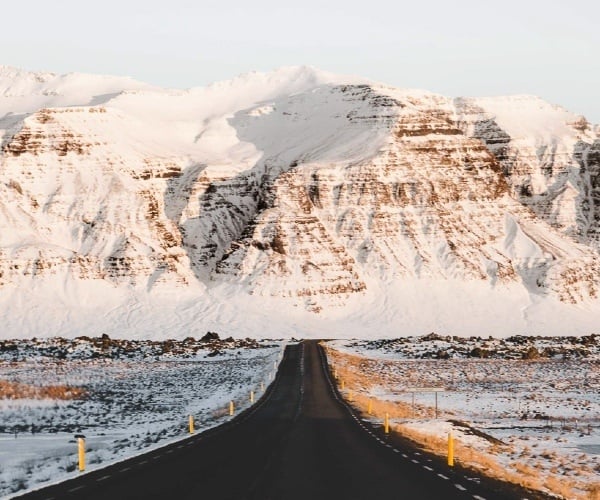 So how do we cope I hear you ask? It must be so hard to get anything done, no? Well actually, coping is not a word that is generally used when referring to this time of the year. In fact, we celebrate it! My colleagues and I prefer this time of year for many reasons and actually it is one of the most popular times of the year for us when running tours. So I thought this month’s blog post could be about the lighter side of the darkest days of the year and what makes them so special (pun intended).
1. Starry, starry nights!
You probably thought I would talk predominantly about the Northern Lights in this post. Don’t worry, I will soon enough. But considering the Northern Lights are elusive and fleeting, it’s not exactly something we locals expect or yearn for at the end of each day. In fact, you’re slightly more likely to see the Northern Lights in September, October and March, despite the shorter night hours. Don’t ask me why, but there is a significant statistical correlation. So maybe, nearing the solstice, all that extra night-time to play with will allow focus on something else as well…the stars and the planets.
So how do we cope I hear you ask? It must be so hard to get anything done, no? Well actually, coping is not a word that is generally used when referring to this time of the year. In fact, we celebrate it! My colleagues and I prefer this time of year for many reasons and actually it is one of the most popular times of the year for us when running tours. So I thought this month’s blog post could be about the lighter side of the darkest days of the year and what makes them so special (pun intended).
1. Starry, starry nights!
You probably thought I would talk predominantly about the Northern Lights in this post. Don’t worry, I will soon enough. But considering the Northern Lights are elusive and fleeting, it’s not exactly something we locals expect or yearn for at the end of each day. In fact, you’re slightly more likely to see the Northern Lights in September, October and March, despite the shorter night hours. Don’t ask me why, but there is a significant statistical correlation. So maybe, nearing the solstice, all that extra night-time to play with will allow focus on something else as well…the stars and the planets.
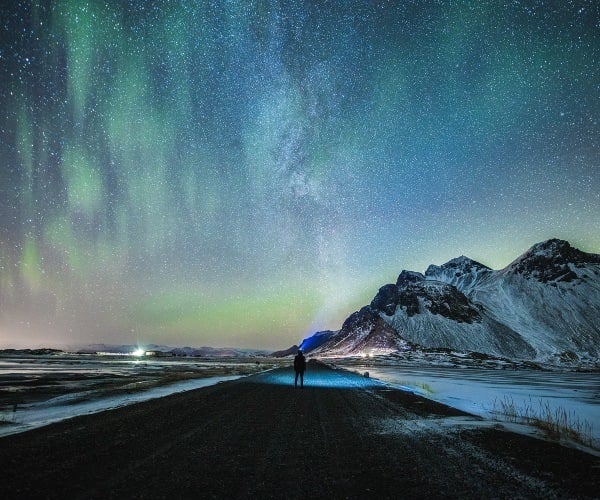 I often tell my guests when we’re out searching for the Northern Lights, “Don’t forget the stars while looking to the heavens.” It sounds stupid but in a country with so little unnatural light thanks to the low population density it is too often overlooked as a prime star gazing location. In October, we were treated to 40 days of Mars being as close to the Earth as it’ll be for the next 150 years and we even had a ‘blue moon’ on Halloween, spooky. A blue moon, for anyone not in the know, is when you get a full moon twice in the same month. A rare treat. For December’s efforts, there will be the Geminid meteor shower brightening the sky, reaching its peak on the 14th of December.
I often tell my guests when we’re out searching for the Northern Lights, “Don’t forget the stars while looking to the heavens.” It sounds stupid but in a country with so little unnatural light thanks to the low population density it is too often overlooked as a prime star gazing location. In October, we were treated to 40 days of Mars being as close to the Earth as it’ll be for the next 150 years and we even had a ‘blue moon’ on Halloween, spooky. A blue moon, for anyone not in the know, is when you get a full moon twice in the same month. A rare treat. For December’s efforts, there will be the Geminid meteor shower brightening the sky, reaching its peak on the 14th of December.
 So the next time you’re watching the sunset and tutting at the fact that you won’t see daylight for another 20 hours, bear in mind that the vast open spaces in Iceland are great for a bit of star gazing too.
2. The Northern Lights
Ok, so it was inevitable that I would mention the Northern Lights. After all, this is one of the main reasons people travel to Iceland in the darker months. Even though you may be slightly more likely to see the Northern Lights closer to the Equinox than the Solstice, it doesn’t mean you don’t still have a good chance in December and January. Actually, these choice few weeks around the darkest days are the only time you are likely to spot the Northern Lights while simply walking home from work or jumping in your car to grab your morning coffee. I was treated to an incredible display recently, shortly after the sun had set as I was walking along the harbour in downtown Reykjavik. Around 5pm if I remember correctly. Now that is a rare sight, let me tell you.
So the next time you’re watching the sunset and tutting at the fact that you won’t see daylight for another 20 hours, bear in mind that the vast open spaces in Iceland are great for a bit of star gazing too.
2. The Northern Lights
Ok, so it was inevitable that I would mention the Northern Lights. After all, this is one of the main reasons people travel to Iceland in the darker months. Even though you may be slightly more likely to see the Northern Lights closer to the Equinox than the Solstice, it doesn’t mean you don’t still have a good chance in December and January. Actually, these choice few weeks around the darkest days are the only time you are likely to spot the Northern Lights while simply walking home from work or jumping in your car to grab your morning coffee. I was treated to an incredible display recently, shortly after the sun had set as I was walking along the harbour in downtown Reykjavik. Around 5pm if I remember correctly. Now that is a rare sight, let me tell you.
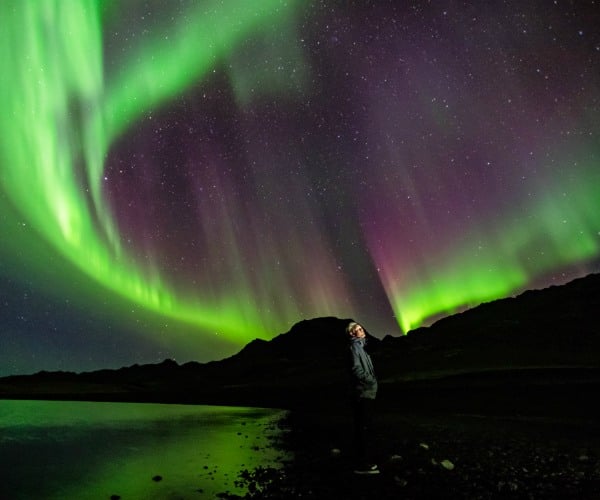 I did say that the locals aren’t sitting on the edge of their seats waiting for the Northern Lights at the end of each day didn’t I? But, that doesn’t mean they don’t love them as much as any tourist. In fact, a few years ago the Northern Lights were so strong over the top of Reykjavik that the city council literally turned off all the street lights to give everyone a better view from the comfort of their own gardens. What a place to call home!
I did say that the locals aren’t sitting on the edge of their seats waiting for the Northern Lights at the end of each day didn’t I? But, that doesn’t mean they don’t love them as much as any tourist. In fact, a few years ago the Northern Lights were so strong over the top of Reykjavik that the city council literally turned off all the street lights to give everyone a better view from the comfort of their own gardens. What a place to call home!
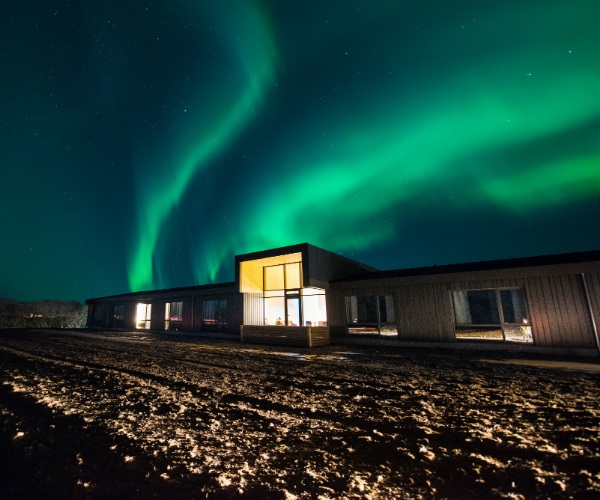 Of course it is still better to get out of the city if you want a great display. Thankfully, ‘getting out of the city’ takes a grand total of 15 minutes in the car. I always recommend booking a hotel outside of Reykjavik for a few nights just to be safe.
3. The Golden ‘Day’
This is in contrast to the ‘golden hour’ that photographers often mention when looking for the best light for that perfect picture. In a week where you only get 4 hours of daylight per day, try to imagine what that looks like for the sun when it has ‘risen’. The sun sleepily rises at 11:30 and takes quite some time to reach its ‘high point’, which believe it or not is barely above the horizon.
Of course it is still better to get out of the city if you want a great display. Thankfully, ‘getting out of the city’ takes a grand total of 15 minutes in the car. I always recommend booking a hotel outside of Reykjavik for a few nights just to be safe.
3. The Golden ‘Day’
This is in contrast to the ‘golden hour’ that photographers often mention when looking for the best light for that perfect picture. In a week where you only get 4 hours of daylight per day, try to imagine what that looks like for the sun when it has ‘risen’. The sun sleepily rises at 11:30 and takes quite some time to reach its ‘high point’, which believe it or not is barely above the horizon.
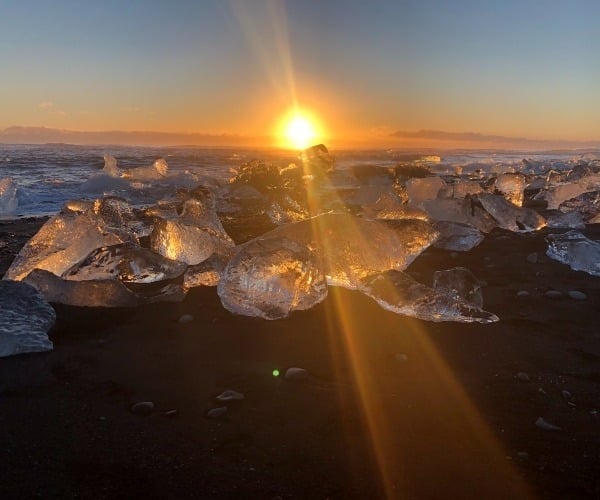 It continues to move horizontally across the sky for a couple of hours and then drops down below the horizon as quickly as it arrived. That basically means that the sun is at the perfect angle all day to light up everything with a golden hue.
It continues to move horizontally across the sky for a couple of hours and then drops down below the horizon as quickly as it arrived. That basically means that the sun is at the perfect angle all day to light up everything with a golden hue.
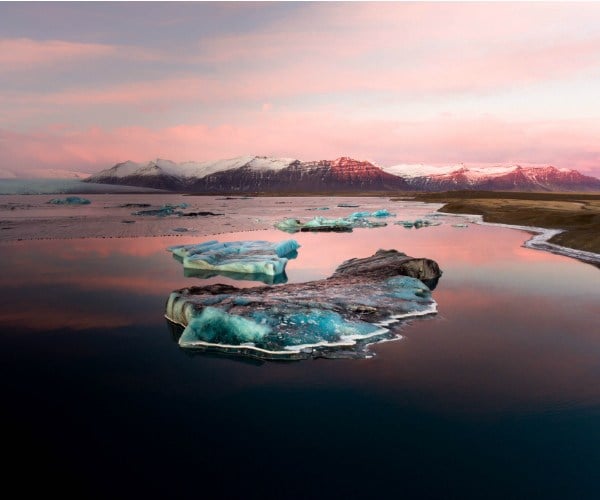 Once you’ve spent the day in the UNESCO World Heritage Site of the Vatnajökull National Park with its shimmering icebergs in the world famous glacier lagoon, its washed up ice blocks on the black diamond beach, and its multi-coloured ice caves, you’ll start to question why anyone would travel at any other time of the year.
Once you’ve spent the day in the UNESCO World Heritage Site of the Vatnajökull National Park with its shimmering icebergs in the world famous glacier lagoon, its washed up ice blocks on the black diamond beach, and its multi-coloured ice caves, you’ll start to question why anyone would travel at any other time of the year.
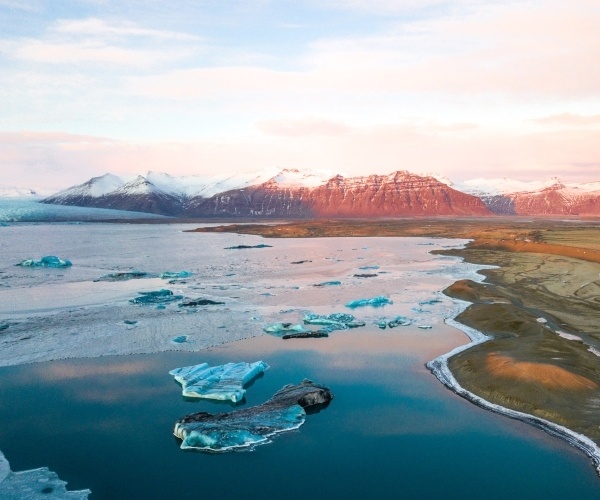 4. Ice caves and blue ice
A little science lesson here if you’ll permit me. When direct sunlight hits blue glacier ice it will make the surface melt and refreeze continuously. This makes the ice crack and spike and appear as a crunchy white surface. This is what the surface of a glacier looks like most of the year. The blue ice is often hidden under that crusty layer.
However, in the darkest days of winter the sun isn’t strong enough to have this effect. Or it simply doesn’t hit the ice for the majority of the day. This means that the ice on the surface stays blue. And when I say blue, I mean blue. It is absolutely incredible to be walking on top of a glacier that is a translucent blue colour. It is even more amazing to step down into the glacier to see the same colour all around you.
4. Ice caves and blue ice
A little science lesson here if you’ll permit me. When direct sunlight hits blue glacier ice it will make the surface melt and refreeze continuously. This makes the ice crack and spike and appear as a crunchy white surface. This is what the surface of a glacier looks like most of the year. The blue ice is often hidden under that crusty layer.
However, in the darkest days of winter the sun isn’t strong enough to have this effect. Or it simply doesn’t hit the ice for the majority of the day. This means that the ice on the surface stays blue. And when I say blue, I mean blue. It is absolutely incredible to be walking on top of a glacier that is a translucent blue colour. It is even more amazing to step down into the glacier to see the same colour all around you.
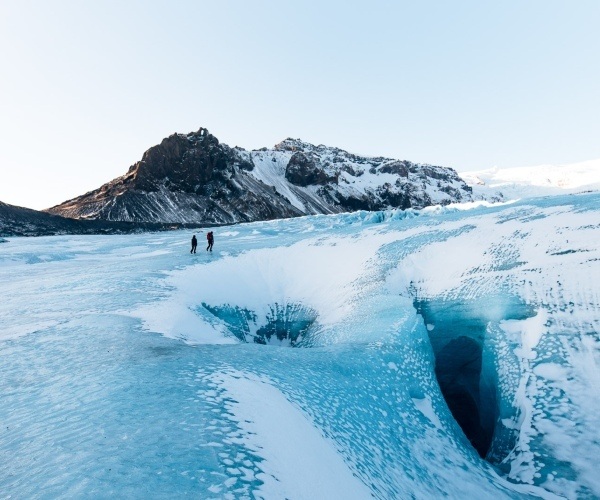 Ice caves are formed in the summer time from movement and melting from the ice. In winter the melting stops and the movement slows. So for a few months of the year it is cold enough for us to safely venture into these hollowed out features. As the darkest days approach it is especially beautiful with the low light often beaming into the holes and cracks of the ice.
Ice caves are formed in the summer time from movement and melting from the ice. In winter the melting stops and the movement slows. So for a few months of the year it is cold enough for us to safely venture into these hollowed out features. As the darkest days approach it is especially beautiful with the low light often beaming into the holes and cracks of the ice.
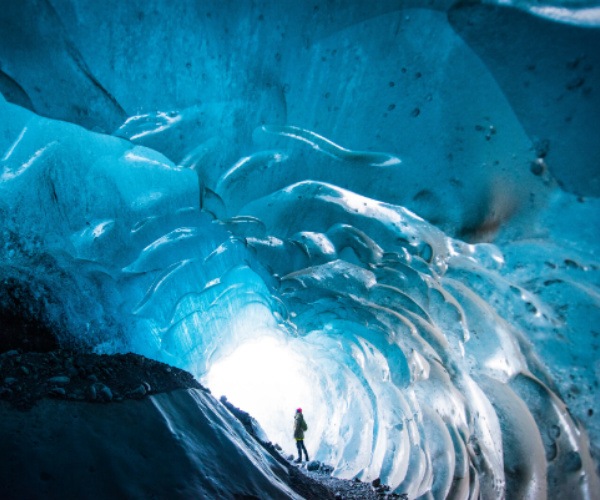 5. Christmas lights and Christmas markets
5. Christmas lights and Christmas markets
if there’s been any year when we’ve truly needed Christmas it’s certainly this yearFun fact time. This year Reykjavik city council turned on the Christmas street lights early. The Mayor, Dagur B. Eggertsson, quipped, “if there’s been any year when we’ve truly needed Christmas it’s certainly this year.” They were lit the day after Halloween. The Christmas cat, ice rink and all the Christmas lights make walking around downtown Reykjavik a magical moment. You almost forget about the cold for a second as you get lost in the twinkling majesty.
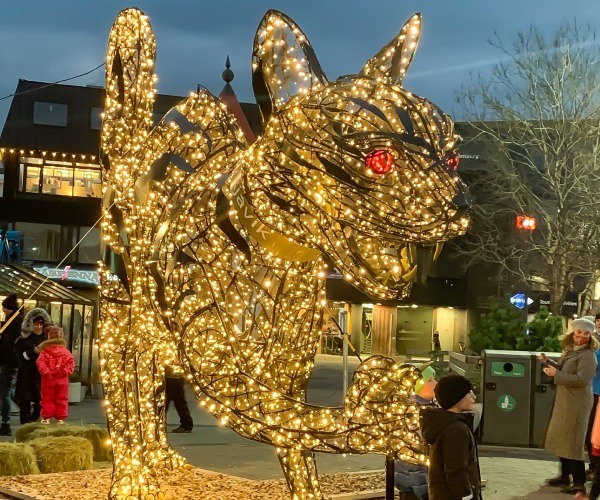 Icelanders celebrate Christmas, that’s for sure. However, their Christmas Day is on the 24th. But, they also have a local tradition that includes gift giving for 13 days in the lead up to Christmas Day by the ‘Yule Lads’. These are mischievous half human, half elves who play tricks on the children in Reykjavik like licking spoons, sniffing doors and stealing candles. This is all true. If you are good, you get a little present. If you are bad you get a potato. This isn’t like in the western world where you give empty threats of ‘if you’re not good Santa won’t bring any presents’. I have friends who have put more potatoes in the shoe than gifts some years. For me, just walking the rainbow coloured streets with lights in every direction is the highlight.
Icelanders celebrate Christmas, that’s for sure. However, their Christmas Day is on the 24th. But, they also have a local tradition that includes gift giving for 13 days in the lead up to Christmas Day by the ‘Yule Lads’. These are mischievous half human, half elves who play tricks on the children in Reykjavik like licking spoons, sniffing doors and stealing candles. This is all true. If you are good, you get a little present. If you are bad you get a potato. This isn’t like in the western world where you give empty threats of ‘if you’re not good Santa won’t bring any presents’. I have friends who have put more potatoes in the shoe than gifts some years. For me, just walking the rainbow coloured streets with lights in every direction is the highlight.
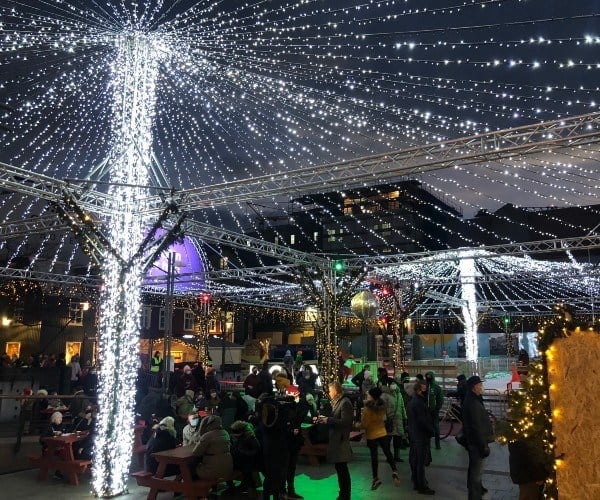 6. New Year Fireworks
On the face of it, fireworks at New Year doesn’t sound like anything special. No different from other countries. But trust me, it’s Iceland. They never quite do things in straight lines. There is of course the mandatory firework display erupting around the Hallgrimskirkja Church at midnight that is exceptional and long. Getting out the house is worth it just for that display alone.
6. New Year Fireworks
On the face of it, fireworks at New Year doesn’t sound like anything special. No different from other countries. But trust me, it’s Iceland. They never quite do things in straight lines. There is of course the mandatory firework display erupting around the Hallgrimskirkja Church at midnight that is exceptional and long. Getting out the house is worth it just for that display alone.
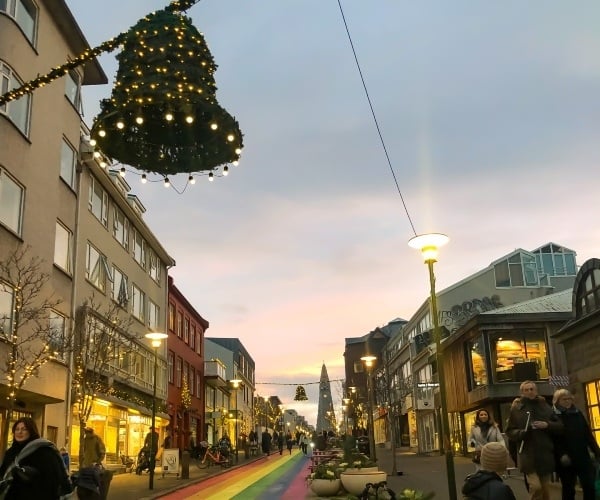 However, the reason Reykjavik’s display is so unique is because it is all for charity. Specifically the Search and Rescue charity. Search and Rescue are a pivotal part of Icelandic culture and are absolutely essential in the dark winter nights. It is an honour to volunteer for them and the respect shown is palpable. Search and Rescue are the only organisation permitted to sell fireworks, and all proceeds go to them as fundraising. So you can imagine how the locals respond to them when being sold. In short, every single household in Reykjavik have their own, not-so-small, display in their gardens. And let’s just say that these displays are not exactly regulated.
However, the reason Reykjavik’s display is so unique is because it is all for charity. Specifically the Search and Rescue charity. Search and Rescue are a pivotal part of Icelandic culture and are absolutely essential in the dark winter nights. It is an honour to volunteer for them and the respect shown is palpable. Search and Rescue are the only organisation permitted to sell fireworks, and all proceeds go to them as fundraising. So you can imagine how the locals respond to them when being sold. In short, every single household in Reykjavik have their own, not-so-small, display in their gardens. And let’s just say that these displays are not exactly regulated.
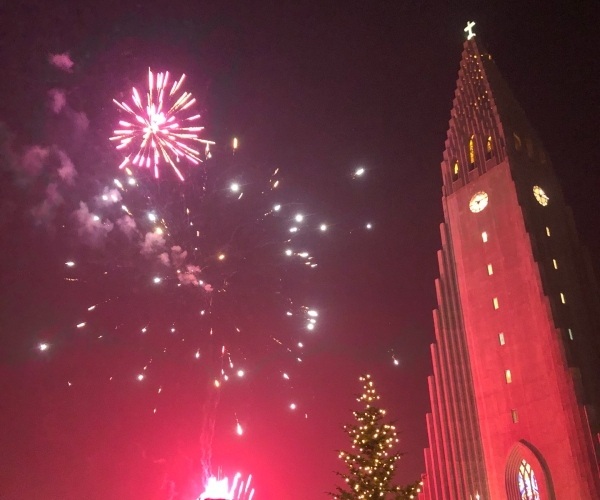 By the time it hits midnight, the number of fireworks set off give Reykjavik the appearance that it’s on fire. No joke. I often exclaim that this is the second reason Reykjavik has its name, which translates to the ‘Smoky Bay’. The smoke that lingers throughout the streets on a windless night is atmospheric and frightening in equal measures.
More recently, due to the effects on climate change the Search and Rescue team are also selling seeds for tree planting purposes too. But make no mistake, there will be plenty of fireworks going off for many years to come.
The Darkest Days Are Worth the Effort
It’s clear that Iceland has plenty to offer during the dark days of the year. However, you may be questioning my enthusiasm. After all, it is the middle of winter on an isolated island in the middle of the Atlantic Ocean, skirting the Arctic Circle. It can’t be all good can it?
By the time it hits midnight, the number of fireworks set off give Reykjavik the appearance that it’s on fire. No joke. I often exclaim that this is the second reason Reykjavik has its name, which translates to the ‘Smoky Bay’. The smoke that lingers throughout the streets on a windless night is atmospheric and frightening in equal measures.
More recently, due to the effects on climate change the Search and Rescue team are also selling seeds for tree planting purposes too. But make no mistake, there will be plenty of fireworks going off for many years to come.
The Darkest Days Are Worth the Effort
It’s clear that Iceland has plenty to offer during the dark days of the year. However, you may be questioning my enthusiasm. After all, it is the middle of winter on an isolated island in the middle of the Atlantic Ocean, skirting the Arctic Circle. It can’t be all good can it?
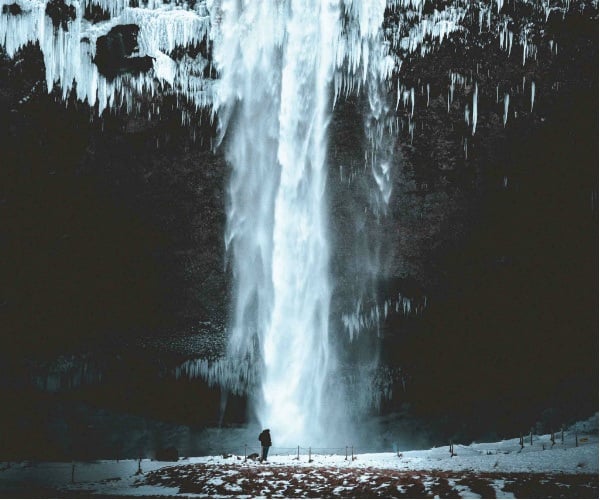 Sadly, you would be partially right. There are a few draw backs at this time of year of course. The shorter days do come with challenges if you are sight seeing and doing adventurous activities like glacier hiking. You can’t exactly walk on a glacier in the dark now can you. The weather can be glorious, like on those golden days, but it can also be quite turbulent too. Last week we were treated to blue skies and starry nights for 4 consecutive days but the previous week we had a hurricane level storm and had to remain indoors. The cold, when mixed with wind can be quite chilling too. The cold is less of an affect than you might think though since the Gulf Stream sends warm water towards Iceland allowing it to be unseasonably warm a lot of the time.
I would say that if you come at this time of year you could be treated to Northern Lights, starry skies, golden days and incredible blue ice caves each day. But pack for the contingency that you may also get a few days with less than favourable weather too. In my humble opinion it is worth the effort of putting up with the harsh days for the glorious ones.
See you next year when travel resumes!
Ryan Connolly is Co-Founder of Hidden Iceland. Hidden Iceland specialises in private trips, taking you to some of the hidden gems of Iceland with a passionate and experienced guide.
If you would like to be a guest blogger on A Luxury Travel Blog in order to raise your profile, please contact us.
Sadly, you would be partially right. There are a few draw backs at this time of year of course. The shorter days do come with challenges if you are sight seeing and doing adventurous activities like glacier hiking. You can’t exactly walk on a glacier in the dark now can you. The weather can be glorious, like on those golden days, but it can also be quite turbulent too. Last week we were treated to blue skies and starry nights for 4 consecutive days but the previous week we had a hurricane level storm and had to remain indoors. The cold, when mixed with wind can be quite chilling too. The cold is less of an affect than you might think though since the Gulf Stream sends warm water towards Iceland allowing it to be unseasonably warm a lot of the time.
I would say that if you come at this time of year you could be treated to Northern Lights, starry skies, golden days and incredible blue ice caves each day. But pack for the contingency that you may also get a few days with less than favourable weather too. In my humble opinion it is worth the effort of putting up with the harsh days for the glorious ones.
See you next year when travel resumes!
Ryan Connolly is Co-Founder of Hidden Iceland. Hidden Iceland specialises in private trips, taking you to some of the hidden gems of Iceland with a passionate and experienced guide.
If you would like to be a guest blogger on A Luxury Travel Blog in order to raise your profile, please contact us.Did you enjoy this article?
Receive similar content direct to your inbox.


Must make life easier for keen photographers when you’ve only got 4 hours between sunrise and sunset.
It depends. Those 4 hours are great for keeping things confined but then you have the following 20 hours of potential Northern Lights photography to contend with too.
In my 20s all I wanted from travel was a beach, wall-to-wall sunshine and great nightlife. Perhaps I’m finally growing up and becoming more mature. Iceland’s slower charms are beginning to be very appealing to me. 5 years ago I wouldn’t have given the Northern Lights a second thought.
I was much the same when I was younger. I even spent a year working on a beach resort in Australia. These days that sounds like a nightmare rather than a paradise.
The Northern Lights and glaciers are far more appealing to me, as long as I have the right clothing to keep me warm.
Envy is alive and kicking! Being one of them city peeps, I seldom get to see the stars in the sky. The occasional bright star (or the planet as it turns out), a few constellations, full moons, eclipses, if I had the mind to look up…but nothing compared to the vastness of the view you have there in Iceland. It’s amazing. I’ve always wanted to capture the Milky Way. It’s also true, I’ve often wondered how you get things done with a few hours of light. I’ve had days when I thought the day wasn’t enough. I would probably be awed and enjoy it as part of my holiday, but not on a daily basis. But I guess you learn to adapt and live with it like you and your friends have.
Yeah, you do learn to adapt quite quickly. It’s the only option if you want to call Iceland home long term. I take vitamin D tablets and my friends have light therapy lamps to emulate daylight. But in the most part I don’t notice it that much. You just do different activities and learn to really appreciate the summers. Though I am a bit biased being a bit of science geek.